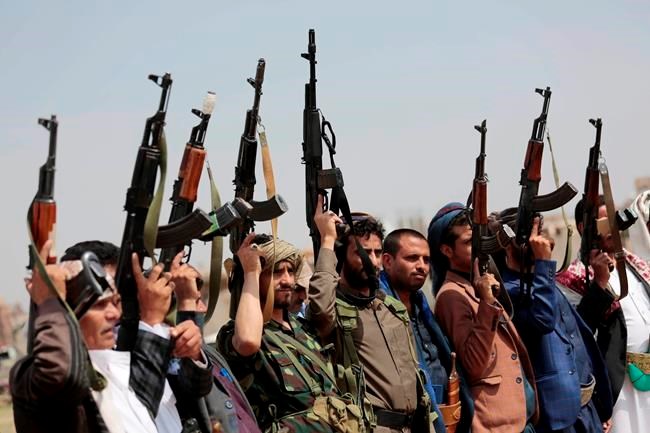DUBAI, United Arab Emirates — A fuel tank at an oil facility in Saudi Arabia caught fire after being struck in an attack by Yemen's Houthi rebels, officials said Friday, an attack that came on the sixth anniversary of the kingdom's entry into Yemen's yearslong civil war.
The assault at Jizan in southwest Saudi Arabia near the border with Yemen came came during what Saudi
A Houthi military spokesman later claimed a series of attacks on several Saudi military sites and oil facilities, some acknowledged by the kingdom and others not.
The kingdom has faced an increasing number of such assaults and the tempo hasn't slowed since it offered a cease-fire deal to the Houthis on Monday.
The attack in Jizan, some 970
“The attack resulted in a fire in one of the terminal’s tanks,” the statement said, without elaborating. “The attack left no casualties.”
Saudi Arabia did not specifically identify the area struck. However, Jizan is home to a new refinery and port facilities for the energy giant Saudi Arabian Oil Co. The refinery, with a capacity of 400,000 barrels a day, sent its first shipment abroad last year. Jizan also is transliterated from Arabic as Jazan by Aramco.
Jizan and its new refinery long have been targeted by Yemen's Houthi rebels in their campaign against the kingdom. However, satellite pictures from Planet Labs Inc. taken Friday morning and analyzed by The Associated Press did not immediately appear to show any damage at that facility.
In a televised speech, Houthi military spokesman Brig. Gen. Yehia Sarie claimed that the rebels targeted several Aramco sites in the cities of Jizan, Ras Tanura, Yanbu and Rabigh with 18 drones and eight ballistic missiles. Sarie also claimed the rebels launched another salvo of 12 drones and eight ballistic missiles at King Abdulaziz Air base in Dammam, as six drones also struck military sites in Asir and Najran provinces.
“The operation has successfully fulfilled its objectives,” Sarie said. “We affirm that we are ready to carry out a more severe and more cruel military operation in the coming period.”
The kingdom did not acknowledge a wave of attacks at the scale. Claims and counterclaims between the kingdom and the rebels have been common throughout the war.
Benchmark Brent crude rose to over $63 a barrel in early trading Friday after the attack. Energy prices have risen recently off growing demand as coronavirus vaccinations increase and Egypt's Suez Canal remains closed due to a massive container ship wedged across the vital waterway.
The Saudi-led coalition entered Yemen’s war on March 25, 2015, as the Houthis threatened to take Yemen’s port city of Aden and completely overrun the country’s internationally recognized government. The Saudis promised that the offensive — the brainchild of Crown Prince Mohammed bin Salman — would be over in short order.
Six years later, the fighting rages on. The war has killed some 130,000 people, including over 13,000 civilians slain in targeted attacks, according to the Armed Conflict Location & Event Project. Tens of thousands of children have died of starvation and disease.
The war also has turned into a regional conflict, with the Saudis using U.S.-made weaponry in internationally criticized airstrikes killing civilians, and Iran being linked to weapons used by the Houthis to target the kingdom.
On Monday, Saudi Arabia offered a new cease-fire proposal to the Houthis. It made two concessions to the Houthis in the plan while not offering everything the rebels previously wanted. The first involves reopening Sanaa International Airport, a vital link for Yemen to the outside world that hasn’t seen regular commercial flights since 2015. Officials did not immediately identify what commercial routes they wanted to see resume.
The second would see taxes, customs and other fees generated by the Hodeida port while importing oil put into a joint account of Yemen’s Central Bank. That account would be accessible to the Houthis and Yemen’s recognized government to pay civil servants and fund other programs, officials said.
The Saudi government and the Yemeni government it backs have accused the Houthis of stealing those funds in the past.
The Houthis did not outright reject the offer, though its officials said they wanted both the airport and Hodeida port reopened without restrictions. U.S. Secretary of State Antony Blinken on Thursday praised the arrival of four fuel ships to Hodeida on a call with the Yemeni Prime Minister Maeen Abdulmalik Saeed as a way to “mitigate the fuel shortage facing the country and get much needed help to the people of Yemen.”
___
Associated Press writer Noha ElHennawy in Cairo contributed to this report.
___
Follow Jon Gambrell on Twitter at www.twitter.com/jongambrellAP.
Jon Gambrell, The Associated Press



